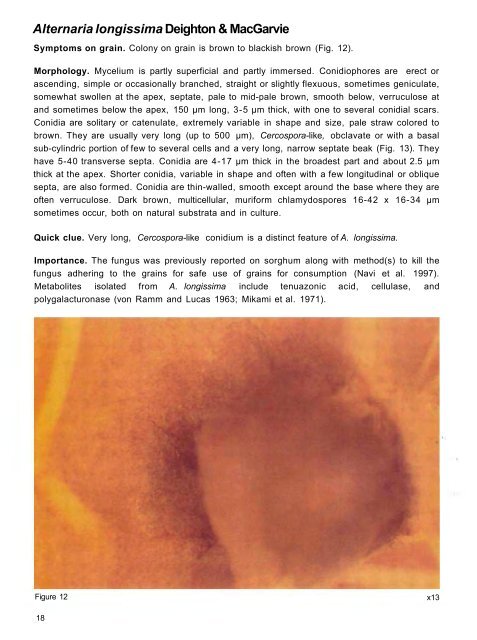A Pictorial Guide for the Identification of Mold ... - OAR@ICRISAT
A Pictorial Guide for the Identification of Mold ... - OAR@ICRISAT
A Pictorial Guide for the Identification of Mold ... - OAR@ICRISAT
You also want an ePaper? Increase the reach of your titles
YUMPU automatically turns print PDFs into web optimized ePapers that Google loves.
Alternaria longissima Deighton & MacGarvie<br />
Symptoms on grain. Colony on grain is brown to blackish brown (Fig. 12).<br />
Morphology. Mycelium is partly superficial and partly immersed. Conidiophores are erect or<br />
ascending, simple or occasionally branched, straight or slightly flexuous, sometimes geniculate,<br />
somewhat swollen at <strong>the</strong> apex, septate, pale to mid-pale brown, smooth below, verruculose at<br />
and sometimes below <strong>the</strong> apex, 150 μm long, 3-5 μm thick, with one to several conidial scars.<br />
Conidia are solitary or catenulate, extremely variable in shape and size, pale straw colored to<br />
brown. They are usually very long (up to 500 μm), Cercospora-like, obclavate or with a basal<br />
sub-cylindric portion <strong>of</strong> few to several cells and a very long, narrow septate beak (Fig. 13). They<br />
have 5-40 transverse septa. Conidia are 4-17 μm thick in <strong>the</strong> broadest part and about 2.5 μm<br />
thick at <strong>the</strong> apex. Shorter conidia, variable in shape and <strong>of</strong>ten with a few longitudinal or oblique<br />
septa, are also <strong>for</strong>med. Conidia are thin-walled, smooth except around <strong>the</strong> base where <strong>the</strong>y are<br />
<strong>of</strong>ten verruculose. Dark brown, multicellular, muri<strong>for</strong>m chlamydospores 16-42 x 16-34 μm<br />
sometimes occur, both on natural substrata and in culture.<br />
Quick clue. Very long, Cercospora-like conidium is a distinct feature <strong>of</strong> A. longissima.<br />
Importance. The fungus was previously reported on sorghum along with method(s) to kill <strong>the</strong><br />
fungus adhering to <strong>the</strong> grains <strong>for</strong> safe use <strong>of</strong> grains <strong>for</strong> consumption (Navi et al. 1997).<br />
Metabolites isolated from A. longissima include tenuazonic acid, cellulase, and<br />
polygalacturonase (von Ramm and Lucas 1963; Mikami et al. 1971).<br />
Figure 12<br />
18<br />
x13
















